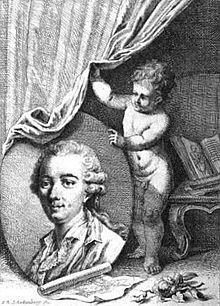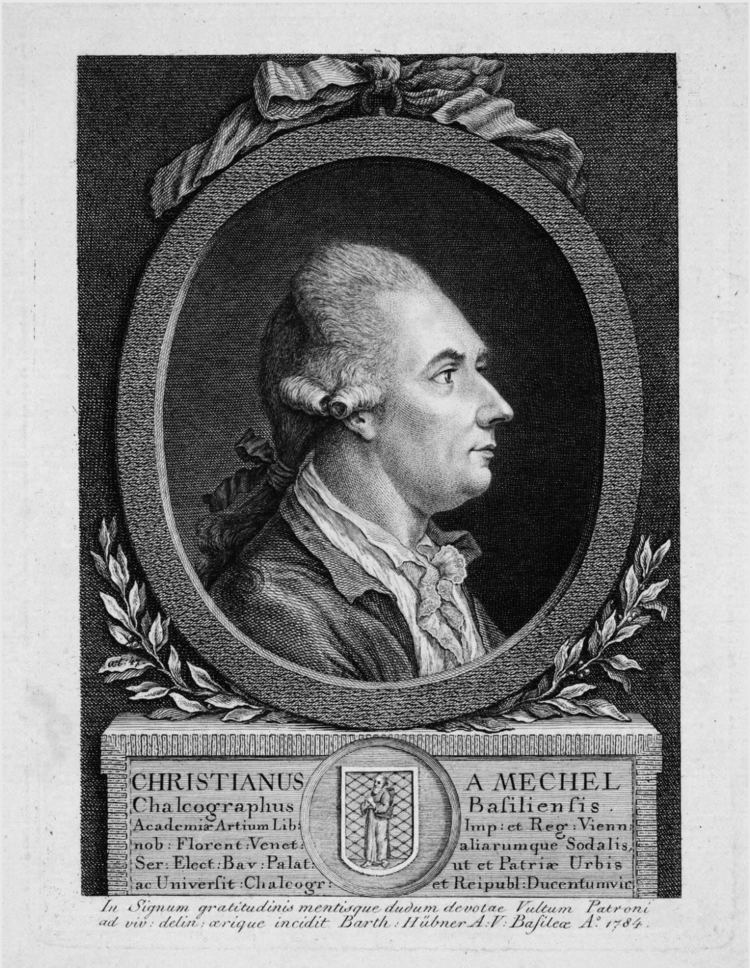Nationality Swiss | Name Christian Mechel | |
 | ||
Full Name Christian von Mechel Notable work La Galerie Electorale De Dusseldorff (1778)Hans Holbein - Le triomphe de la mort (1780)Verzeichnis der Gemalde der Kaiserlich Koniglichen Bilder-Gallerie in Wien (1783)Entwurf einer Kunstgeschichte Helvetiens (1791)Lucas Cranach's Stammbuch (1814);Bildnisse sammtlicher zu dem Throne von Frankreich zuruckberufenen Bourbons (1814) Died April 11, 1817, Berlin, Germany | ||
Christian von Mechel (4 April 1737 in Basel; † 11 April 1817 in Berlin) was a Swiss engraver, publisher and art dealer. He developed a broad trade in art, through business connections throughout northern and central Europe; although the French Revolutionary Wars ruined him financially, he started over in 1805 in Berlin.
Contents
- Life
- Business venture
- Participation in development of Imperial Art Gallery
- Work during the French Revolutionary Wars and Napoleonic Wars
- Importance
- Works
- References

Although trained in art and copper etching, he found his niche as a purveyor of art. Joseph II employed him to convert the private Habsburg collection to one available for public display. He was one of the first curators to employ schools of art as a mnenomic system of organization.
Life
Christian von Mechel came from a long-established family of artisans in Basel. His father John (1813-07) and grandfather Josias both worked as a coopers, and his mother Salome (Bulacher) was the daughter of a guild master; the family name itself dates to the 16th century, and his maternal great grandfather, Christian Munch (1678-1747) had been master of the guilds and a Basel magistrate. Originally destined for a career in the clergy, Christian Mechel attended the Basel Latin School. Early, however, he showed a marked interest in art. In the 1750s, as construction in Basel flourished, it occurred to his parents that art might be a lucrative business and he was permitted to pursue this study. In 1753 he visited Augsburg to learn the engraving discipline from Georg Daniel Heumann. In 1757 he briefly worked in Johann Georg Pintz's workshop in Nuremberg. From 1757 to 1764 he lived in Paris, where he studied with Johann Georg Wille and later launched his own studio, where he produced his own work and sold other objets d'art. In 1761, he married Elisabeth Haas (1740–86), the daughter of a respected type caster Johannes Wilhelm Haas from Nurnburg. In 1795, he married again to Friederike von Wagner, daughter of the banker and financier Ludwig Friedrich von Wagner, of Regensburg, but they divorced the following year. Both marriages were childless.
Business venture
Mechel thrived in Paris, learning how to deal with rich clients and developing a feel for the art market. Soon, the businessman, the art dealer and the artist were combined into one; he began signing his name to works produced by talented apprentices and selling them as his own. He returned to Basel in 1765 and in 1766 opened a large art dealer's business and engraving workshop in the St. Johannes quarter of the city (the Vorstadt). He no longer produced anything himself, but supervised 12-15 artists. His shop became a tourist destination in and of itself, promoted by his own excellent connections. As his reputation grew, travelers stopped at his shop in the Vorstadt to buy his prints. He maintained a large magazine of prints, and carried on a sizable trade. Mechel soon became known internationally in the art trade and acquired such important and famous customers as Johann Wolfgang von Goethe and Emperor Joseph, who visited the Mechel studio during his stay in Basel in July 1777. Mechel later accompanied the emperor on his journey to Waldshut on 26 July 1777.
On a trip to Italy in 1767, Mechel met Johann Joachim Winckelmann and Johann Friedrich Reiffenstein, who regularly supplied him with Italian art for sale in his studio and shop. He taught applied drawing at the University of Basel and, in 1786, Mechel was officially entrusted with the supervision of Basel's Hans Holbein the Younger collection. He also held an office in the Basel Magistrates, in the select inner council. During these productive years, he published several volumes, including Vorstellungen und Plane der merkwürdigsten Begebenheiten des gegenwärtigen Krieges der Österreicher und Russen gegen die Türken (1790) (Ideas and plans of the most remarkable events of the present war the Austrians and Russians against the Turks);Explication des renvois de l'estampe enluminée, qui représente la vallé de Chamouni, le Mont-Blanc et les montagnes adjacentes (1791) (Explanation of the print references illuminated, which represents the valley of Chamouni, Mont Blanc and the adjacent mountains) and Entwurf einer Kunstgeschichte Helvetiens (1791) (History of Swiss Art).
Participation in development of Imperial Art Gallery
In 1776 Maria Theresa and her son, Emperor Joseph II decided to transfer the k.u.k. Gemäldegalerie ("Imperial Picture Gallery") from the Imperial Stables — a part of the city's Hofburg Imperial Palace — to the Upper Belvedere, and reflected an eighteenth-century trend shaped by the Enlightenment. To display art to the public required also a shift in perspective. Art, including sculpture, paintings, lithographs, drawings, etc. had been considered for years the domain of the upper classes for who it was deemed suitable. To display such treasures to the hoi polloi required, the cultured and refined classes believed, explanations to the unlettered and uninformed. Consequently, Joseph entrusted Mechel with the organization, cataloging and display of his large and important collection. To prepare the art for exhibit, Joseph wished Mechel to organize, catalog. Mechel applied a scientific perspective to organize works of art by masters, time periods, and schools that was emulated, copied, and expanded throughout European art collectors and their curators. and display what became known as the Imperial Picture Gallery for public showing. The gallery opened five years later, making it one of the first public museums in the world. The opening of the Musée du Louvre during the French Revolution in 1793 as a public museum included much of the former French royal collection marked an important stage in the development of public access to art by transferring the ownership to a republican state; but it was a continuation of trends already well established. Michel was also instrumental in organizing and cataloging this material.
Work during the French Revolutionary Wars and Napoleonic Wars
A trip through the southern German states followed another trip to Vienna in 1787. In 1789, he traveled again through southern Germany, the Rhineland, and the Netherlands; once in the Netherlands, he went to England, to the Court of George III. In 1794 he returned to Basel, where he saw the impact of the French Revolution on his art dealing business. Fighting in and around Basel, both the city Canton and the countryside, made business difficult. In 1796, he was directly affected by the Rhine Campaign; from his home in Basel he could see the nearby Hüningen, drawings of which he published in 1797. Complicating matters for him, his business suffered due to the lack of tourists purchasing his art and prints, and because of the general lack of money. His publication of, for example, Itinéraire du St. Gothard, d'une partie de Vallais et des contrées de la Suisse, que l'on traverse ordinairement pour se rendre au Gothard (1795) (The St. Gotthard Itinerary: part of Vallais and regions of Switzerland; and Views of Switzerland drew on the popularity of emerging importance of the Grand Tour for the wealthy.
With such political turmoil, people had other things upon which to spend their time and energy. Mechel attempted to capitalize on local events in the ongoing warfare with France with the publication of Tableaux historiques et topographiques, ou relations exactes et impartiales des trois événemens mémorables qui terminèrent la campagne de 1796 sur le Rhin (1798) (Historical and topographical paintings, accurate and impartial relationship or three memorable events that ended the 1796 campaign on the Rhine); and Soldaten- und Plotons-Schule für die Infanterie aus dem französischen Reglement (1799) During the mid-1790s he speculated, often unwisely, in the purchase of art from large collections from the French emigre noble families. These ventures, mostly unsuccessful, forced him into bankruptcy.
The political and economic turmoil caused by the French revolutionary wars made him country-less and homeless and in 1797 he fled Basel. For several years, Mechel traveled throughout Germany, moving from city to city, often on foot, plying his knowledge of art, cataloging and organization in exchange for shelter and sustenance. At a stop in Frankfurt am Main, he cataloged the artwork of the Dominican monastery, then moved on to Kassel and Weimar, where he met again with Goethe, and made the acquaintance of Schiller. In Dresden he furthered his acquaintance with the Swiss painters Anton Graff and Adrian Zingg and finally settled in Berlin in 1805. There he negotiated his membership in the Royal Academy of Art. In 1806disbanded his ruined business in Basel and seemed to find some stability. Afterward, he produced, in collaboration with Wilhelm von Humboldt and others, luxurious printed editions showcasing the work of such Reformation artists as Lucius Cranach the Younger. He never again attained the wealth and influence he had wielded for those twenty years in Basel. He died in 1817 in Berlin.
Importance
In addition to his work of selling art, Mechel developed a wide audience for Hans Holbein the Younger with his work on Totentanz. As president of the Swiss Society for Art Galleries, which he founded in 1791, he wrote the first art history of Switzerland. Mechel was also one of the first art historians to create art exhibits based on the newly developed concept of painting schools. His organization of the Habsburg collection by "schools" (for example, Italian schools, Dutch schools, etc.) and his physical placement of these in specific rooms, one leading to another, as if leading the viewer through a timeline of development, laid the groundwork for the form of art history. Furthermore, his business in Basel made him an important man. He became a Ratsherr (member of the city council) and a member of Isaac Iselin's Helvetic Society, among the most enlightened and liberal members of Basel elite.
